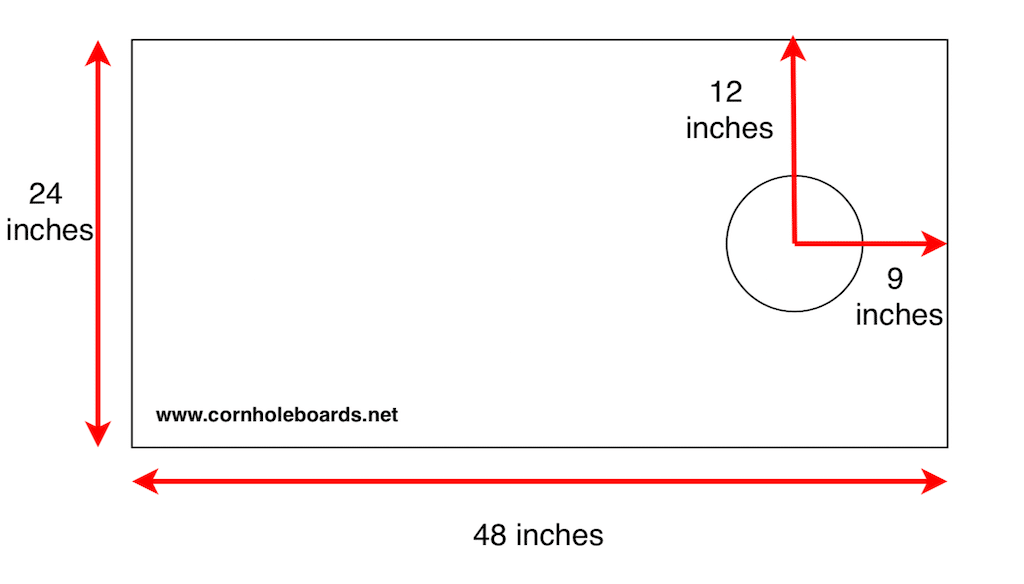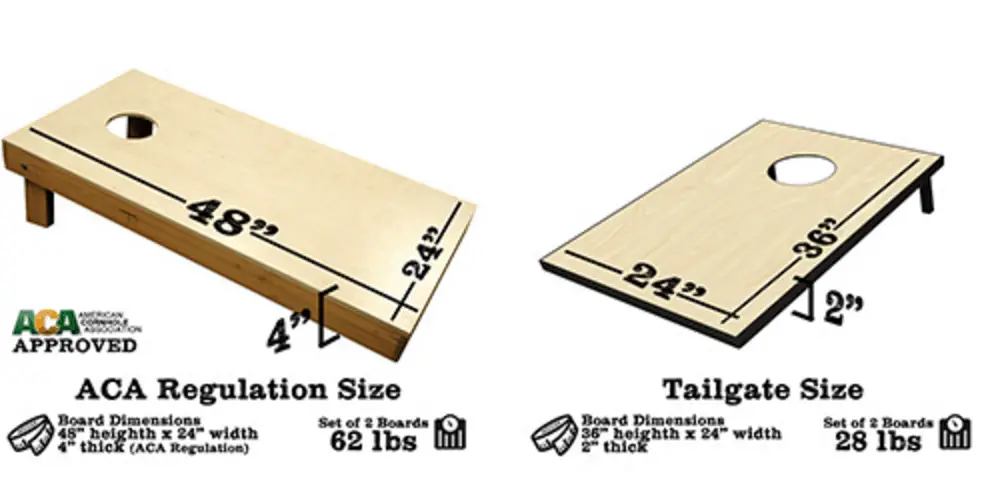Corn Hole Boards Regulation Size
When it comes to outdoor games, few can match the fun and excitement of cornhole. Whether you're a seasoned cornhole enthusiast or just starting to dabble in the game, having the right cornhole boards is crucial. In this article, we'll take a look at regulation size cornhole boards and guide you on how to create your own set. So, let's dive in and explore the world of cornhole boards!
1. What are Regulation Cornhole Boards?

Cornhole is a popular game that consists of two sets of boards placed on opposite ends of a playing area. The goal is to toss bean bags onto the boards and score points based on where the bags land. Regulation cornhole boards are built to specific dimensions to ensure fairness and consistency in gameplay.
A regulation cornhole board is a rectangular wooden platform with a cutout hole at the top end. The dimensions of a regulation board are 48 inches in length and 24 inches in width. The hole should have a diameter of 6 inches and be placed 9 inches from the top of the board. These specific measurements ensure that the game is played on a level playing field, no matter where you are.
2. Building Your Own Regulation Cornhole Boards

If you're the creative type or simply enjoy DIY projects, building your own regulation cornhole boards can be a rewarding and cost-effective option. Here's a step-by-step guide to help you create your very own cornhole set:
Step 1: Gather Your Materials
To get started, you will need the following materials:
- Two 48-inch by 24-inch plywood boards (1/2 inch to 3/4 inch thick)
- Four 48-inch by 4-inch boards for the frame
- Eight 22-inch by 4-inch boards for the legs
- Screws
- Saw
- Measuring tape
- Paint or wood stain
Step 2: Cut and Assemble the Boards
Start by cutting the plywood boards to the correct dimensions of 48 inches by 24 inches. These will serve as the top surface of your cornhole boards. Next, cut the four 48-inch by 4-inch boards for the frame and attach them to the edges of the plywood boards, creating a box-like structure. Secure the frame with screws for added stability.
Once the frame is in place, attach the eight 22-inch by 4-inch boards to act as legs for your cornhole boards. Position the legs at a 10-degree angle from the ground and secure them to the frame using screws. This angle provides better stability during gameplay.
Step 3: Finishing Touches
With the basic structure complete, it's time to add some finishing touches to your cornhole boards. Sand down any rough edges or surfaces to ensure a smooth playing experience. You can also apply paint or wood stain to customize the look of your boards. Consider adding a clear sealant to protect the wood from weathering if you plan to use your boards outdoors.
3. Tips for Customizing Your Cornhole Boards
Now that you have the basic structure of your cornhole boards, it's time to let your creativity shine through. Here are some tips for customizing your boards and making them truly unique:
- Add your favorite sports team's logo or colors.
- Use stencils to create intricate designs or patterns.
- Apply decals or vinyl stickers for a professional finish.
- Experiment with different paint colors and textures.
The possibilities are endless when it comes to customizing your cornhole boards. Get creative and make your boards a reflection of your personality and style!
Frequently Asked Questions (FAQ)
Q: Can I use any type of wood for my cornhole boards?
A: While any type of wood can technically be used to build cornhole boards, it's best to choose a durable and weather-resistant wood, such as plywood or medium-density fiberboard (MDF). These materials will ensure that your boards last longer and can withstand outdoor conditions.
Q: How high should the cornhole boards be from the ground?
A: Regulation cornhole boards should be positioned at a height of approximately 12 inches from the ground to the top of the playing surface. This height allows for optimal gameplay and ensures that the bags can be easily tossed onto the boards.
Q: Can I make my cornhole boards smaller or larger than regulation size?
A: While it's possible to make your cornhole boards smaller or larger than regulation size, it's important to note that doing so may impact the gameplay and scoring. Regulation size boards provide a standard playing field and are commonly used in cornhole tournaments and official competitions.
Conclusion
Cornhole boards are an essential component of the popular game, and having regulation size boards ensures fairness and consistency in gameplay. Whether you choose to build your own boards or purchase them from a store, the key is to enjoy the game and have fun with your friends and family. So why wait? Gather your materials, put on your creative hat, and let the cornhole fun begin!
Regulation Cornhole Board DIY Plans PDF | Etsy | Diy Cornhole Boards
 Image Source : www.pinterest.com
Image Source : www.pinterest.com cornhole
Cornhole Boards | Platforms | Cornhole Board Dimensions, Cornhole, Diy
 Image Source : www.pinterest.dk
Image Source : www.pinterest.dk Tailgate Size (3’x1.5’) Cornhole Boards - Diversityandcivilitytraining.com
 Image Source : diversityandcivilitytraining.com
Image Source : diversityandcivilitytraining.com Regulation-Size Cornhole Boards - Grok42
 Image Source : grok42.com
Image Source : grok42.com cornhole regulation
The Best Cornhole Boards : A Buyer's Guide - Sport Consumer
 Image Source : sportconsumer.com
Image Source : sportconsumer.com cornhole boards dimensions board regulation size official distance front must good aca quality equal evaluation role important play also
Show Me Your Cornhole Boards (pic Thread) - AR15.COM
How To Build A Regulation Cornhole Set | How-tos | DIY
corn cornhole hole game diy build board regulation set make games boards dimensions drawing toss bag bean diynetwork bags designs
No Bags Included One Color Cornhole Boards Bean Bag Toss Toys & Games
 Image Source : aloli.ru
Image Source : aloli.ru How to build a regulation cornhole set. No bags included one color cornhole boards bean bag toss toys & games. Show me your cornhole boards (pic thread). Cornhole boards. Regulation cornhole board diy plans pdf